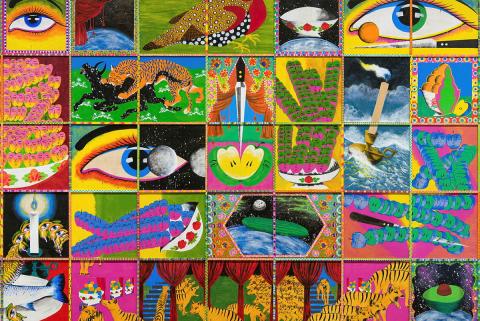Iman Raad: Days of Bliss and Woe
By Ellie Buttrose
The 9th Asia Pacific Triennial of Contemporary Art November 2018
A riot of colour and movement, Iman Raad’s artworks advocate for ornamentation and decoration in art and architecture. His paintings, drawings, murals and banners reconfigure and reimagine influences from ‘glitch’ aesthetics, Persian miniature painting, Iranian folk art and Pakistani truck painting.
For his ambitious, large-scale mural commissioned for APT9, Raad takes inspiration from daily life, referencing the heavily ornamented trucks and buses of South Asia. This painting tradition — with subjects ranging from lush natural landscapes to Islamic symbolism — was inspired by Mughal painting, which developed from Persian miniature painting. Raad is interested in how elements of Persian painting have been adapted and transformed. The ornate trucks are like mobile galleries and Raad’s mural for APT9 is intended to be viewed on the move — visitors capture glimpses from the foyer below, and the artwork comes into full view from the escalator between floors, while close-up views are taken between galleries. In addition, the giddy repetition of images affords the viewer’s eye quick movement across the surface of the wall.
Persia has a long history of mural painting that continues today; the practice of wall painting dates back to the late third century BCE, although the earliest surviving examples are from the third century CE.1 In addition, abstract mosaic works adorn the public spaces, palaces and places of worship throughout the region. Like these public murals, Raad’s artworks also respond specifically to their sites; for APT9, for instance, the composition responds to visitors’ close viewing distance (due to the width of the walkway) and the soaring height of the wall. The artist draws on this history of public art and combines it with contemporary subject matter to create his painted installations. Raad’s practice differs from historical precedents in that he uses a highly keyed palette and altered perspective, together with a mix of contemporary imagery.
Ornamentation is key to both Persian miniature painting and to the truck painters of Karachi. In Raad’s highly ornamental artworks, ubiquitous subjects such as birds, fruit and flowers (often found in the decorative borders of Persian miniatures) are repositioned as central subjects that carry new narrative weight. It is these subjects, intertwined with social events and historical moments and rendered in fantastical ways, which draw the viewer in to Raad’s creations.
The importance of ornamentation is also apparent in Raad’s textiles that are draped across the Gallery’s foyer, softening the concrete and glass of GOMA’s architecture. These embroidered velvet banners reference the flags that are prolifically displayed during annual Ashura festivities in Iran, when the Shiite population mourns the death of Imam Hussain, the grandson of the prophet Muhammad. The artist works with artisans in Mashhad, who adapt and transform Raad’s drawings into tapestries; subjects range from figures adrift at sea to North American space endeavours, and the tree of life. These works celebrate and mourn life and death in its many forms.
Iman Raad’s practice is informed by a belief in the centrality of vernacular art forms to the wider history of art.
Endnote
- Sheila R Canby, ‘Mural painting’, Encyclopædia Iranica, 13 November 2015, viewed June 2018.
Connected objects

Days of bliss and woe 2018
- RAAD, Iman - Creator
Related artists
RAAD, Iman
1979
- present
Full profile
for RAAD, Iman